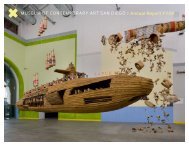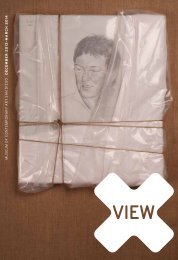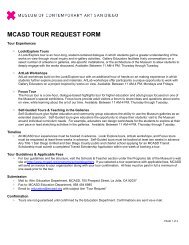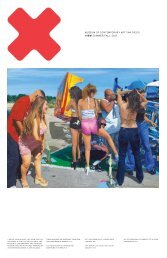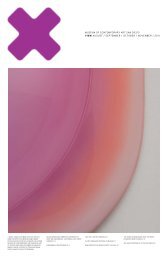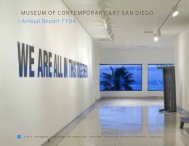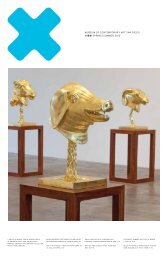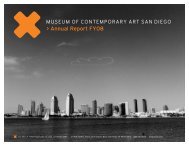APRILâ Ju L y 2 013 - Museum of Contemporary Art San Diego
APRILâ Ju L y 2 013 - Museum of Contemporary Art San Diego
APRILâ Ju L y 2 013 - Museum of Contemporary Art San Diego
- No tags were found...
You also want an ePaper? Increase the reach of your titles
YUMPU automatically turns print PDFs into web optimized ePapers that Google loves.
INSIDE SCOOPHow was the transition from the ICE Galleryreally connected, and now Joey’s actually histo Bread & Salt? Does it feel like a momentpersonal assistant.for re-invention/re-interpretation <strong>of</strong> yourLee: MCASD has taught me so much aboutartistic goals?contemporary art. They’ve helped me expo-Thomas: This is an exciting time for us. We werenentially in talking about it, understanding it,at ICE in North Park for a little over two years,and handling it. The environment is perfect forand now it feels like the right moment to beme because I live and breathe art twenty-fourdoing something like this. When you’re creatinghours a day: I read art books, draw, and trysomething, no matter what it is or where youto visit other museums. If I’m not involved inHANGING WITH THE ICE GALLERY GUYSSometimes the most interesting thing in a <strong>Museum</strong> isn’t the arton the walls—it’s who’s hanging it.are, it feels like re-invention every time.Lee: It’s important to keep working and expandingyour vocabulary because the process <strong>of</strong>creating is extremely important. You have tocontinually challenge yourself. It’ll be similar toworking in ICE, but the location is different. Thisart, I feel really guilty. It’s like an itch I have toscratch.MCASD: Do you intend to collaborate withother artists who will eventually inhabitthe space?Four young artists, formerly <strong>of</strong> the ICE Galleryin North Park, opened an exhibition in Februaryat Bread & Salt, an abandoned yet serviceable40,000 square foot warehouse built in 1891.The Logan Heights building, which housed theformer Weber bakery, is being transformed intoa multi-purpose environment for communitygalleries, event spaces, and live-work artistunits by James Brown <strong>of</strong> Public Architecture.Thomas DeMello, Lee Lavy, Joseph Huppert,and Michael James Armstrong were <strong>of</strong>feredthe opportunity to use the space however theywished. All four artists have been preparators(a.k.a. art handlers) at MCASD. The group’sLee Lavy: The running thread between us is thatwe continually move from one project to thenext. We all have different relationships to art.I’ve been drawing since I was 4 or 5 years old -just sketching and making stuff. I figured no onecared. I’d actually never shown any <strong>of</strong> my workuntil I started working at Blick <strong>Art</strong> Supplies.Thomas DeMello: I’ve been an artist my wholelife. I used to turn in blank exams at school andcall it art. This is really personal to me. I dreamabout art, I love to talk about it, and I feel enlivevedby the conversations we have at CaféBassam on Sundays. Everyone we meet there isso creative.LEE LAVY (LEFT), AND THOMAS DEMELLO (RIGHT). PHOTOS: JEWEL GOODE.will be like our continuation in a new space.MCASD: Two members <strong>of</strong> the group, Thomasand Lee, are currently preparators for MCASD.How have the things you’ve learned therechanged your perspective about and relationshipto art?Thomas: Getting this job was like a dream, andI’d probably do it for free just because I love itso much. We’re always trying to find a way tocome together and connect with people aboutart on any level; people who are passionateand creative. We’re always learning somethingnew there, and we’re fortunate to meetamazing people like Bob Irwin. He and JoeyLee: We’re not really collaborators, but sometimeswe do fight like brothers. It all comesdown to a shared work ethic and respect forone another.Michael: We’re supportive in aspects like labor,but it’s probably better to say that we helpeach other with execution and not aesthetics.We’re all friends, and we try to help each otherachieve our goals.Thomas: The goal is always to help someonemake it happen. If an opportunity to collaboratecomes along, we’ll really think about it. Mostly,we all want to be on a course to see that workgets finished.unique approach to art has allowed them to fullyexploit the potential <strong>of</strong> such a raw environment.MCASD: What factors have influenced yourWe sat down with the group to learn more aboutwork for the current exhibition at Bread & Salt?their practice and their new digs.Thomas: I’m drawn to this idea <strong>of</strong> inhabiting anuninhabitable space and producing work that isMCASD: How would you describe your work,site-specific. In that way, Bread & Salt has theas a group or individually?same kind <strong>of</strong> origins as the ICE Gallery. We don’tMichael Armstrong: As a group, we’re allhave an artist manifesto, we never put wall labelscompletely different. I don’t think we shareon the art, and we never serve food or drinks atanything as far as aesthetics. At the moment,opening receptions. We just want people to gothe focus is on site-conditioning/site-specificlook at art for as long as they can stand it.installations where the site informs the work.Lee: That’s a quality not many places have. Wealso don’t want to be known as a gallery becausethere aren’t any objects or art to sell.22 23



